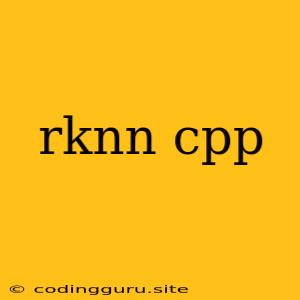Delving into the World of RKNN and C++: A Comprehensive Guide
RKNN, a powerful framework from Rockchip, empowers developers to harness the full potential of their hardware for efficient inference tasks. RKNN utilizes the C++ language for its implementation, making it a robust and versatile tool for machine learning applications.
This guide will delve into the intricate world of RKNN and C++, providing a comprehensive overview of its capabilities, functionalities, and best practices.
What is RKNN?
At its core, RKNN is a software framework designed to streamline the process of running deep learning models on Rockchip hardware. RKNN acts as a bridge between your trained neural network model and the underlying Rockchip hardware.
RKNN offers a plethora of advantages, including:
- Simplified Deployment: The framework simplifies the deployment process of deep learning models onto Rockchip chips. It handles the complexities of model optimization and execution, allowing developers to focus on their applications.
- Optimized Performance: RKNN leverages the unique architecture of Rockchip hardware to maximize performance. It tailors the model for optimal execution, resulting in faster inference speeds and reduced resource consumption.
- Flexibility and Scalability: RKNN provides a flexible and scalable platform for deploying diverse neural network architectures. You can utilize models trained using frameworks like TensorFlow, PyTorch, and ONNX.
Why C++?
The choice of C++ as the backbone of RKNN is strategic. C++, known for its efficiency and control over system resources, is perfectly suited for tasks like:
- High-Performance Computing: The ability to manage memory directly, coupled with powerful optimization techniques, makes C++ an ideal choice for applications requiring high-performance computation.
- Real-time Applications: C++'s deterministic nature and low-level control are crucial for real-time applications where precise timing and predictable behavior are essential.
- Resource Management: C++ provides developers with granular control over hardware resources, allowing them to optimize memory usage and performance for embedded systems with limited resources.
Getting Started with RKNN and C++
Here's a basic guide to get you started with RKNN and C++:
-
Setting up the Environment: Begin by installing the RKNN toolkit. You can download the latest version from the Rockchip website. The toolkit includes libraries, headers, and documentation that you will need.
-
Model Conversion: RKNN requires models in its native format. You can use the provided tools to convert models trained using frameworks like TensorFlow, PyTorch, or ONNX.
-
Code Structure: Your C++ code will interact with the RKNN library to:
- Load and initialize the converted model.
- Prepare input data for inference.
- Perform inference using the RKNN API.
- Retrieve and process the output from the model.
-
Example Code:
#include#include int main() { // Initialize RKNN context rknn_context ctx; rknn_init(&ctx); // Load the converted model rknn_model model; rknn_load_model(ctx, "model.rknn", &model); // Prepare input data float input_data[100]; // ... Populate input_data ... // Perform inference rknn_input input; input.index = 0; // Index of the input tensor input.type = RKNN_TENSOR_TYPE_FLOAT32; input.size = sizeof(input_data); input.data = input_data; rknn_run(ctx, &input, NULL); // Retrieve output data // ... (Code for processing the output data) ... // Release resources rknn_destroy(ctx); return 0; }
Advanced Techniques
RKNN offers a plethora of features and capabilities beyond basic inference. You can:
- Optimize Models: Utilize various optimization techniques like quantization, pruning, and model distillation to further enhance performance.
- Batch Inference: Improve efficiency by performing inference on multiple samples simultaneously.
- Memory Management: Implement memory management strategies to optimize resource consumption, particularly on devices with limited memory.
- Advanced API Features: Explore the advanced features of the RKNN API, including tensor manipulation, performance monitoring, and custom operations.
Troubleshooting
When working with RKNN and C++, you may encounter errors or unexpected behavior. Here are some common issues and tips for troubleshooting:
- Incorrect Model Conversion: Double-check the model conversion process. Ensure that the model is compatible with RKNN and that the conversion settings are appropriate.
- Memory Allocation: Pay close attention to memory allocation, especially when dealing with large models or datasets. Use debuggers or profiling tools to detect memory leaks.
- Device Compatibility: Confirm that your Rockchip hardware is compatible with the RKNN version you are using. Refer to the documentation for supported devices and hardware requirements.
- API Errors: Thoroughly read the RKNN API documentation and error messages to understand the cause of any errors.
Conclusion
RKNN, in conjunction with the power of C++, opens up a world of possibilities for developers working with machine learning applications on Rockchip hardware. By leveraging the capabilities of RKNN and the flexibility of C++, you can create innovative solutions with efficient performance and reduced development time. As you dive deeper into the world of RKNN and C++, you will discover an array of tools and techniques to take your machine learning projects to the next level.
